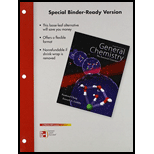
Interpretation:
From the given information, the time taken for the concentration of A to be four times that of B has to be calculated.
Concept introduction:
The first order reaction:
It is a reaction whose rate depends on the reactant concentration whose power is raised to one in the rate expression.
Consider a reaction:
In this reaction, the reactant
The rate expression for the considered reaction can be given as follows:
-Ve sign indicates the decrease in concentration of the reactant A.
The integrated form of the first order rate expression is:
Half-life: The time required for half of a reactant to be consumed in a reaction is said to be half-life. It is represented by the symbol as
The expression for the half-life period in first order kinetics:
Answer to Problem 14.70QP
The time taken for the concentration of A to be four times that of B is
Explanation of Solution
Given:
Calculating the rate constants from the given half-lives:
Let the rate constant for the reaction with the reactant A be
Therefore,
Let the rate constant for the reaction with the reactant B be
Therefore,
The initial concentrations for A and B are equal. So,
The final concentrations of A is four times of B are equal. So,
Using the integrated rate expression of first order kinetics, the initial and the final concentrations can be equated as follows:
Therefore, the time taken for the concentration of A to be four times of B is
The time taken for the concentration of A to be four times has been calculated.
Want to see more full solutions like this?
Chapter 14 Solutions
Loose Leaf For General Chemistry With Connect Access Card
 ChemistryChemistryISBN:9781305957404Author:Steven S. Zumdahl, Susan A. Zumdahl, Donald J. DeCostePublisher:Cengage Learning
ChemistryChemistryISBN:9781305957404Author:Steven S. Zumdahl, Susan A. Zumdahl, Donald J. DeCostePublisher:Cengage Learning ChemistryChemistryISBN:9781259911156Author:Raymond Chang Dr., Jason Overby ProfessorPublisher:McGraw-Hill Education
ChemistryChemistryISBN:9781259911156Author:Raymond Chang Dr., Jason Overby ProfessorPublisher:McGraw-Hill Education Principles of Instrumental AnalysisChemistryISBN:9781305577213Author:Douglas A. Skoog, F. James Holler, Stanley R. CrouchPublisher:Cengage Learning
Principles of Instrumental AnalysisChemistryISBN:9781305577213Author:Douglas A. Skoog, F. James Holler, Stanley R. CrouchPublisher:Cengage Learning Organic ChemistryChemistryISBN:9780078021558Author:Janice Gorzynski Smith Dr.Publisher:McGraw-Hill Education
Organic ChemistryChemistryISBN:9780078021558Author:Janice Gorzynski Smith Dr.Publisher:McGraw-Hill Education Chemistry: Principles and ReactionsChemistryISBN:9781305079373Author:William L. Masterton, Cecile N. HurleyPublisher:Cengage Learning
Chemistry: Principles and ReactionsChemistryISBN:9781305079373Author:William L. Masterton, Cecile N. HurleyPublisher:Cengage Learning Elementary Principles of Chemical Processes, Bind...ChemistryISBN:9781118431221Author:Richard M. Felder, Ronald W. Rousseau, Lisa G. BullardPublisher:WILEY
Elementary Principles of Chemical Processes, Bind...ChemistryISBN:9781118431221Author:Richard M. Felder, Ronald W. Rousseau, Lisa G. BullardPublisher:WILEY





